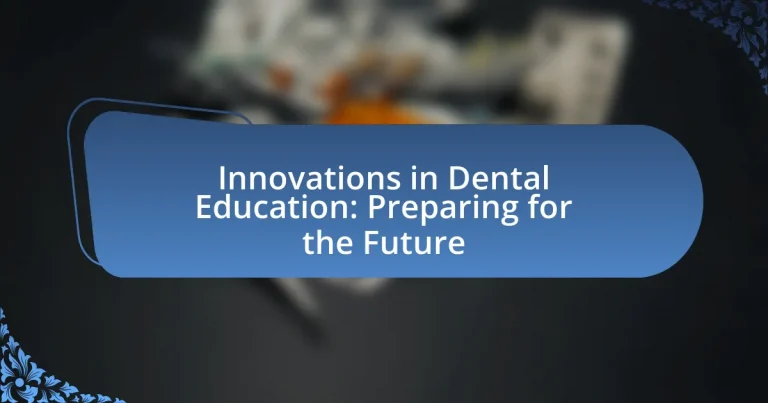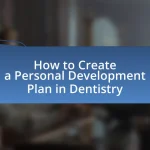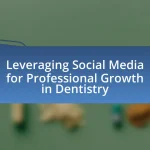The article focuses on key innovations in dental education that are shaping the future of the field. It highlights the integration of digital technology, simulation-based learning, and interprofessional education as essential components for enhancing student engagement and clinical competency. Technological advancements, such as virtual reality and online learning platforms, are transforming traditional teaching methodologies, while simulation technology provides a safe environment for skill development. The article also discusses the importance of continuous professional development and collaborative partnerships in improving educational outcomes and preparing dental students for modern healthcare challenges.
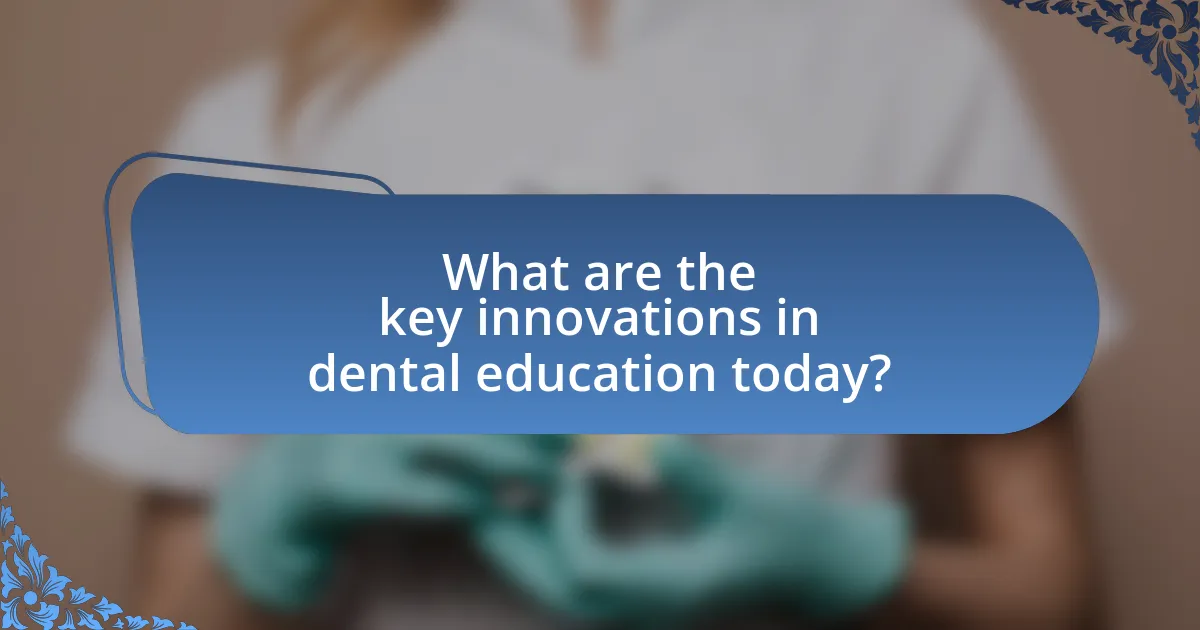
What are the key innovations in dental education today?
Key innovations in dental education today include the integration of digital technology, simulation-based learning, and interprofessional education. Digital technology, such as virtual reality and augmented reality, enhances the learning experience by providing immersive simulations that allow students to practice procedures in a risk-free environment. Simulation-based learning, including the use of manikins and advanced dental simulators, enables students to develop their clinical skills before working on real patients. Interprofessional education fosters collaboration among dental students and other healthcare professionals, preparing them for team-based care. These innovations are supported by research indicating improved student engagement and competency in clinical skills, as evidenced by studies published in journals like the Journal of Dental Education.
How are technological advancements shaping dental education?
Technological advancements are significantly shaping dental education by integrating digital tools and innovative methodologies into the curriculum. For instance, the use of virtual reality (VR) and augmented reality (AR) allows dental students to practice procedures in a simulated environment, enhancing their hands-on skills without the risks associated with real patients. Research published in the Journal of Dental Education indicates that students who trained with VR technology demonstrated improved procedural knowledge and confidence compared to traditional methods. Additionally, online learning platforms and tele-dentistry have expanded access to education, enabling students to learn from experts worldwide and participate in remote consultations, thus broadening their clinical exposure and understanding of diverse practices.
What role does simulation technology play in training dental students?
Simulation technology plays a crucial role in training dental students by providing a safe and controlled environment for practice. This technology allows students to develop clinical skills without the risk of harming real patients, enabling them to gain hands-on experience with procedures such as cavity preparation and tooth extraction. Research indicates that dental students who utilize simulation technology demonstrate improved proficiency and confidence in their skills compared to those who rely solely on traditional methods. For instance, a study published in the Journal of Dental Education found that students trained with simulation techniques scored significantly higher in practical assessments, highlighting the effectiveness of this approach in enhancing educational outcomes.
How is virtual reality being utilized in dental education?
Virtual reality is being utilized in dental education to enhance the learning experience through immersive simulations. These simulations allow dental students to practice procedures in a risk-free environment, improving their skills and confidence before working on real patients. Research indicates that VR training can lead to better retention of knowledge and improved clinical performance, as evidenced by a study published in the Journal of Dental Education, which found that students using VR technology demonstrated a 30% increase in procedural accuracy compared to traditional methods.
What new teaching methodologies are emerging in dental education?
New teaching methodologies emerging in dental education include simulation-based learning, problem-based learning, and the integration of digital technologies such as virtual reality and augmented reality. Simulation-based learning allows students to practice clinical skills in a risk-free environment, enhancing their hands-on experience. Problem-based learning encourages critical thinking and collaborative skills by presenting real-world clinical scenarios for students to solve. The use of digital technologies, including virtual and augmented reality, provides immersive learning experiences that can improve understanding of complex anatomical structures and procedures. These methodologies are supported by research indicating that they enhance student engagement and improve learning outcomes in dental education.
How does problem-based learning enhance dental training?
Problem-based learning enhances dental training by promoting critical thinking and clinical reasoning skills among students. This educational approach engages learners in real-world scenarios, requiring them to analyze complex problems, collaborate with peers, and apply theoretical knowledge to practical situations. Research indicates that dental students who participate in problem-based learning demonstrate improved diagnostic skills and greater retention of knowledge compared to traditional learning methods. A study published in the Journal of Dental Education found that students exposed to problem-based learning scored higher on assessments measuring clinical competence, highlighting its effectiveness in preparing future dental professionals.
What is the impact of interprofessional education on dental students?
Interprofessional education (IPE) significantly enhances the competencies of dental students by fostering collaborative skills essential for effective patient care. IPE promotes teamwork among healthcare professionals, which is crucial in addressing complex health issues. Research indicates that dental students who engage in IPE demonstrate improved communication skills, a better understanding of the roles of other healthcare providers, and increased confidence in collaborative practice. A study published in the Journal of Dental Education found that dental students participating in IPE reported higher levels of readiness for interprofessional collaboration compared to those who did not participate. This evidence underscores the positive impact of IPE on preparing dental students for future healthcare environments.
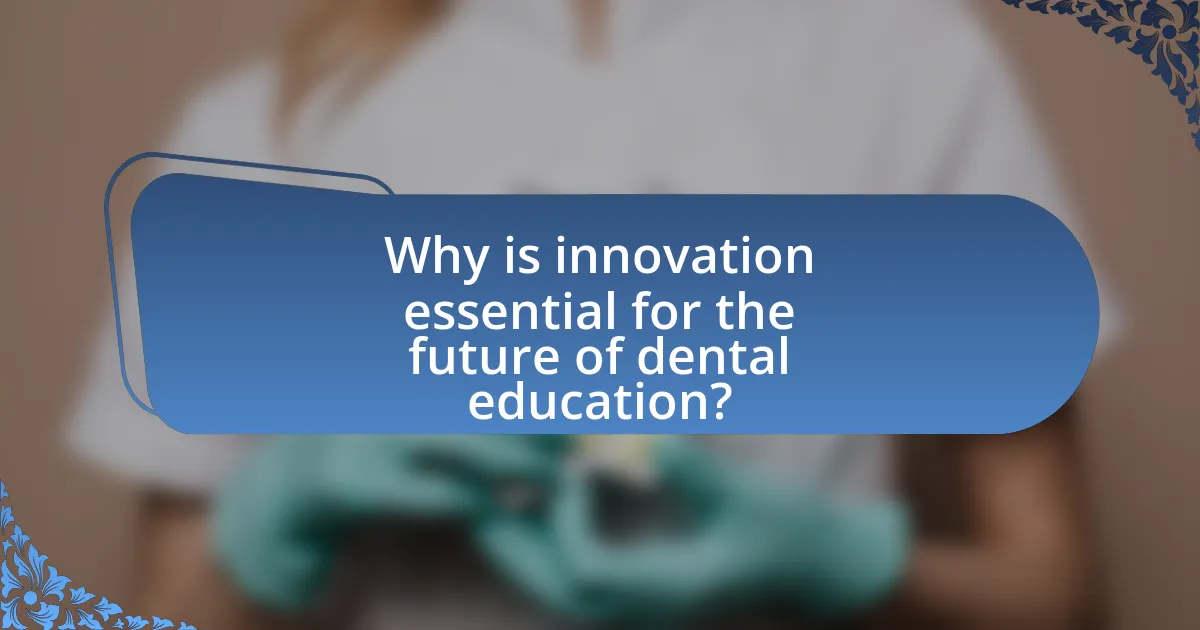
Why is innovation essential for the future of dental education?
Innovation is essential for the future of dental education because it enhances the quality of training and prepares students for evolving industry demands. The integration of advanced technologies, such as virtual reality and artificial intelligence, allows for more effective simulation-based learning, which has been shown to improve clinical skills and decision-making abilities among dental students. Research indicates that institutions adopting innovative teaching methods report higher student engagement and better retention of knowledge, ultimately leading to improved patient care outcomes.
How do innovations address current challenges in dental education?
Innovations in dental education address current challenges by integrating advanced technologies such as virtual reality (VR), simulation-based learning, and online platforms. These technologies enhance hands-on training, allowing students to practice procedures in a risk-free environment, which is crucial given the increasing complexity of dental procedures. For instance, a study published in the Journal of Dental Education found that VR training improved students’ procedural skills and confidence levels significantly compared to traditional methods. Additionally, online learning platforms provide flexible access to educational resources, accommodating diverse learning styles and schedules, which is essential in a field that requires continuous education due to evolving practices and technologies.
What are the limitations of traditional dental education methods?
Traditional dental education methods are limited by their reliance on passive learning, lack of hands-on experience, and insufficient integration of technology. These methods often emphasize rote memorization over critical thinking and practical skills, which can hinder students’ ability to apply knowledge in real-world scenarios. For instance, a study published in the Journal of Dental Education found that traditional lecture-based formats do not effectively prepare students for clinical practice, as they lack opportunities for active engagement and problem-solving. Additionally, the absence of modern technological tools, such as simulation and virtual reality, restricts students’ exposure to innovative techniques and procedures, further limiting their preparedness for contemporary dental practice.
How can innovations improve student engagement and retention?
Innovations can significantly improve student engagement and retention by incorporating interactive technologies and personalized learning experiences. For instance, the use of virtual reality (VR) in dental education allows students to practice procedures in a simulated environment, enhancing their hands-on skills and confidence. A study published in the Journal of Dental Education found that students who engaged with VR training reported higher levels of satisfaction and retention of knowledge compared to traditional methods. Additionally, adaptive learning platforms can tailor educational content to individual student needs, ensuring that learners remain engaged and motivated. Research indicates that personalized learning approaches can lead to a 30% increase in student retention rates. Thus, integrating innovative technologies and personalized strategies in dental education fosters a more engaging and effective learning environment, ultimately improving student outcomes.
What are the expected outcomes of implementing innovations in dental education?
The expected outcomes of implementing innovations in dental education include enhanced student engagement, improved clinical skills, and better preparedness for real-world practice. Innovations such as simulation technology and digital learning platforms have been shown to increase student interaction and retention of knowledge, leading to a more effective learning experience. For instance, a study published in the Journal of Dental Education found that students using simulation-based learning demonstrated a 30% improvement in clinical performance compared to traditional methods. Additionally, integrating new technologies prepares graduates to meet the evolving demands of the dental profession, ensuring they are equipped with the latest skills and knowledge necessary for success in their careers.
How will innovations affect the competency of future dental professionals?
Innovations will significantly enhance the competency of future dental professionals by integrating advanced technologies and methodologies into dental education and practice. For instance, the incorporation of virtual reality (VR) and augmented reality (AR) in training allows students to simulate complex procedures in a risk-free environment, thereby improving their practical skills and decision-making abilities. Research from the Journal of Dental Education indicates that students using VR technology demonstrated a 30% increase in procedural accuracy compared to traditional methods. Additionally, innovations such as artificial intelligence (AI) in diagnostics enable dental professionals to make more informed decisions, leading to better patient outcomes. The integration of these technologies into curricula ensures that future dental professionals are not only proficient in traditional techniques but also adept at utilizing cutting-edge tools, ultimately elevating the standard of care in dentistry.
What benefits do patients gain from advancements in dental education?
Patients gain improved dental care from advancements in dental education. Enhanced training for dental professionals leads to better diagnostic skills, updated treatment techniques, and a deeper understanding of patient needs. For instance, research indicates that dental graduates who receive contemporary education are more adept at using advanced technologies, such as digital imaging and laser treatments, which can result in more accurate diagnoses and less invasive procedures. Furthermore, ongoing education ensures that practitioners stay informed about the latest evidence-based practices, ultimately improving patient outcomes and satisfaction.
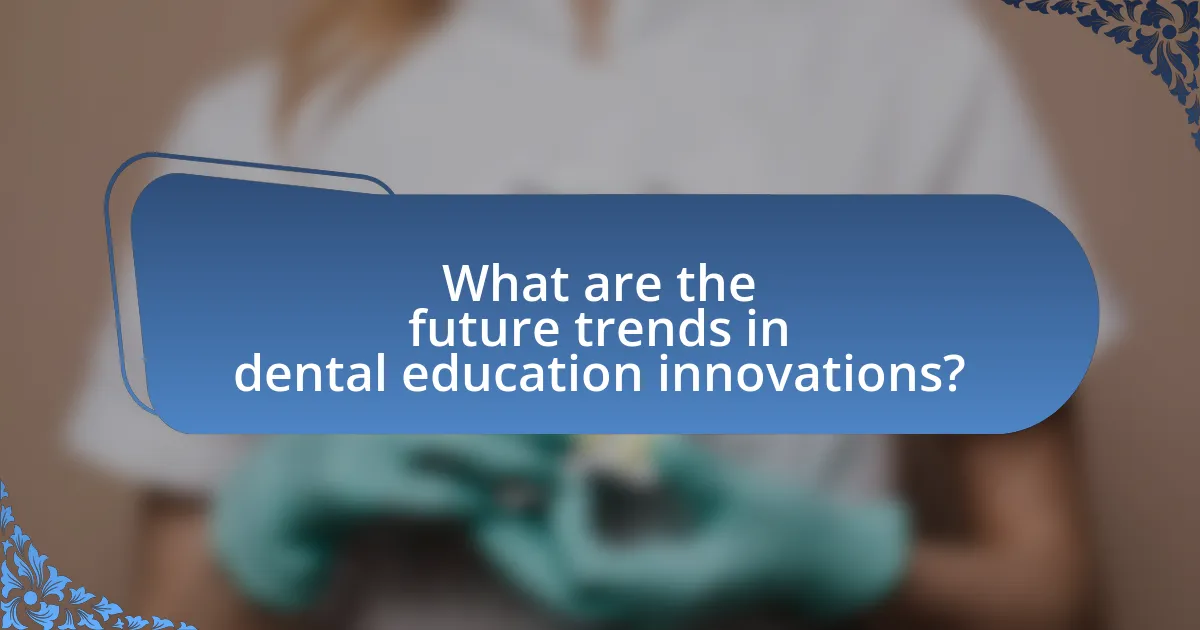
What are the future trends in dental education innovations?
Future trends in dental education innovations include the integration of virtual reality (VR) and augmented reality (AR) technologies, which enhance hands-on training and simulation experiences for students. Research indicates that VR and AR can significantly improve learning outcomes by providing immersive environments for practicing clinical skills without the risks associated with real-life procedures. Additionally, the use of artificial intelligence (AI) in personalized learning pathways is emerging, allowing educators to tailor curricula to individual student needs, thereby improving engagement and retention. Furthermore, interprofessional education is gaining traction, promoting collaboration among dental students and other healthcare disciplines to foster a more holistic approach to patient care. These trends are supported by studies showing that such collaborative models enhance communication skills and teamwork among future healthcare providers.
How is online learning transforming dental education?
Online learning is transforming dental education by providing flexible access to resources and enhancing interactive learning experiences. This shift allows dental students to engage with a variety of digital tools, such as virtual simulations and online lectures, which can improve their understanding of complex procedures. For instance, studies have shown that the use of virtual reality in dental training can increase retention rates and practical skills among students. Additionally, online platforms facilitate collaboration and communication among students and instructors, fostering a more inclusive learning environment. This transformation is supported by the increasing integration of technology in educational curricula, which aligns with the evolving demands of the dental profession.
What are the advantages of hybrid learning models in dental training?
Hybrid learning models in dental training offer flexibility, enhanced engagement, and improved access to resources. These models combine online and in-person instruction, allowing students to learn at their own pace while still benefiting from hands-on experiences. Research indicates that hybrid learning can lead to better retention of information and higher student satisfaction, as it accommodates diverse learning styles and schedules. For instance, a study published in the Journal of Dental Education found that students in hybrid programs reported increased motivation and engagement compared to traditional learning environments. This adaptability not only prepares students for real-world scenarios but also fosters a more personalized educational experience.
How can online platforms enhance access to dental education?
Online platforms can enhance access to dental education by providing flexible, scalable, and diverse learning resources. These platforms enable students to access a wide range of courses, webinars, and interactive modules from anywhere in the world, breaking geographical barriers. For instance, the American Dental Association offers online continuing education courses that allow dental professionals to learn at their own pace, which has been shown to increase participation rates significantly. Additionally, online platforms facilitate collaboration and networking among students and educators, fostering a community of learning that can lead to improved educational outcomes.
What role does continuous professional development play in dental education?
Continuous professional development (CPD) plays a crucial role in dental education by ensuring that dental professionals remain updated with the latest advancements in techniques, technologies, and best practices. CPD facilitates lifelong learning, which is essential in a field that constantly evolves due to new research and innovations. For instance, studies indicate that dental practitioners who engage in CPD are more likely to adopt evidence-based practices, leading to improved patient outcomes and enhanced clinical skills. Furthermore, regulatory bodies often require a certain number of CPD hours for license renewal, underscoring its importance in maintaining professional standards and competency in dental care.
How can lifelong learning be integrated into dental practice?
Lifelong learning can be integrated into dental practice through continuous professional development programs, online courses, and participation in workshops and conferences. These methods allow dental professionals to stay updated with the latest advancements in techniques, technologies, and research findings. For instance, the American Dental Association emphasizes the importance of ongoing education, stating that dentists should complete a minimum of 15 hours of continuing education annually to maintain their licenses. This structured approach not only enhances clinical skills but also fosters a culture of learning within dental practices, ultimately improving patient care and outcomes.
What resources are available for ongoing education in dentistry?
Ongoing education in dentistry is supported by various resources including accredited dental schools, online courses, professional organizations, and continuing education conferences. Accredited dental schools offer advanced degree programs and specialized training, while online platforms like Coursera and ADA CE Online provide flexible learning options. Professional organizations such as the American Dental Association and the Academy of General Dentistry offer resources, webinars, and certification programs to enhance skills. Additionally, conferences like the Greater New York Dental Meeting and the Chicago Dental Society Midwinter Meeting provide networking opportunities and access to the latest research and technologies in the field. These resources ensure that dental professionals stay updated with current practices and innovations.
What best practices should dental educators adopt for future readiness?
Dental educators should adopt a curriculum that integrates technology, interprofessional collaboration, and evidence-based practice to ensure future readiness. Incorporating digital tools such as virtual simulations and tele-dentistry prepares students for modern clinical environments. Research indicates that 70% of dental schools have begun integrating technology into their curricula, reflecting a shift towards more innovative teaching methods. Additionally, fostering interprofessional education enhances teamwork skills, which are essential in contemporary healthcare settings. Evidence-based practice training equips students with the ability to apply the latest research to clinical decision-making, improving patient outcomes. These best practices collectively position dental educators to effectively prepare students for the evolving landscape of dental care.
How can dental schools effectively implement innovative teaching strategies?
Dental schools can effectively implement innovative teaching strategies by integrating technology, such as virtual reality and simulation-based learning, into their curricula. Research indicates that the use of simulation in dental education enhances students’ clinical skills and confidence, as evidenced by a study published in the Journal of Dental Education, which found that 85% of students reported improved performance after engaging in simulation exercises. Additionally, fostering a collaborative learning environment through team-based projects and peer teaching can further enhance the educational experience, as collaborative learning has been shown to improve critical thinking and problem-solving skills among dental students.
What partnerships can enhance the quality of dental education programs?
Collaborations with dental schools, healthcare organizations, and industry partners can significantly enhance the quality of dental education programs. These partnerships allow for the integration of advanced technologies, such as simulation training and digital dentistry, into the curriculum, which has been shown to improve student competency and confidence. For instance, partnerships with technology companies can provide access to cutting-edge dental software and equipment, facilitating hands-on learning experiences. Additionally, affiliations with healthcare organizations can offer students clinical exposure and real-world practice opportunities, which are essential for developing practical skills. Research indicates that dental programs with strong industry ties report higher student satisfaction and better job placement rates, underscoring the value of these collaborations in preparing future dental professionals.
